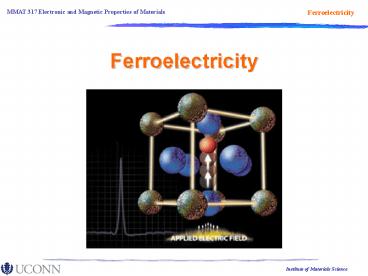Ferroelectrics Lecture - PowerPoint PPT Presentation
1 / 50
Title: Ferroelectrics Lecture
1
Ferroelectricity
2
OUTLINE
- Introduction
- Polarization, Capacitance, Dielectric Properties
- Spontaneous Polarization
- Dielectric Response
- Pyroelectricity
- Electrostriction and Piezoelectricity
- Switching of Polarization via an Electric Field
- Structural Aspects of the Ferroelectric Phase
Transformation - Landau Theory of Ferroelectric Phase
Transformations - Elastic Domains (Twinning) in Ferroelectrics
- Extrinsic Contribution due to Domain Phenomena
- Applications
3
Polarization, Capacitance, Dielectric Properties
4
Polarization, Capacitance, Dielectric Properties
5
Polarization, Capacitance, Dielectric Properties
6
- Typical Perovskite Ferroelectrics
- Pb(Zr,Ti)O3-PZT
- Ba(Sr,Ti)O3-BST
- KNbO3 and LiNbO3
- Pb(Ca,Ti)O3 -PCT
- Pb(Sr,Ti)O3 PST
- Pb(Mg1/3Nb2/3)O3-PbTiO3
- Properties
- Spontaneous polarization in the absence applied
electrical field. - Extremely high dielectric constant (500-15,000).
- Strong non-linear dielectric response to an
applied electrical field. - High strain response to applied electrical field
? piezoelectricity - Strong variation in polarization with temperature
? pyroelectricity
7
Typical Ferroelectric Materials
8
Some Important Definitions
D electrical displacement ? dielectric
constant E electrical field Ec coercive
field dijk piezoelectric coefficient (third rank
tensor) p pyroelectric coefficient Qijkl
electrostrictive coefficient (fourth rank tensor)
9
Spontaneous Polarization and Self-Strain
10
Spontaneous Polarization and the Hysteresis
11
Dielectric Constant Slope of the P vs. E curve
Paraelectric
Ferroelectric
Field dependence of dielectric permittivity ?
TUNABILITY
12
Temperature Dependence of Spontaneous Polarization
PYROELECTRICITY
13
Electrostriction Coupling between Polarization
and Self-Strain
? for BaTiO3 and PbTiO3, ?Q12?ltQ11 and Q12lt0.
14
Piezoelectric effect Strain due to an applied
electric field
Strain due to combined Electrostrictive and
Piezoelectric effect
Under non-zero external stress
15
Polarization Switching by an Electric Field
Sawyer and Tower circuit CF ferroelectric
capacitor CQ standard load capacitor
16
Polarization Switching by an Electric Field
Applied field E and switching current I versus
time for a BaTiO3 crystal. The curve marked A is
the switching pulse when the applied field is
anti-parallel to the polarization, and the curve
B is obtained when the field is parallel to the
polarization and no switching occurs.
17
Polarization Switching by an Electric Field
Electrical (or 1800-domains) to minimize
depolarization.
18
Polarization Switching by an Electric Field
Switching via Reversible Domain Wall Motion
Nucleation and Growth
19
Structural Aspects of Ferroelectric Phase
Transformations
20
Landau Theory of Ferroelectric Phase
Transformations
21
Landau Theory of Ferroelectric Phase
Transformations
All Landau coefficients positive Second-Order
Transformation
22
Landau Theory of Ferroelectric Phase
Transformations
A0, Cgt0, Blt0 First-Order Transformation
23
Landau Theory of Ferroelectric Phase
Transformations
24
Landau Theory of Ferroelectric Phase
Transformations
25
Landau Theory of Ferroelectric Phase
Transformations
For a tetragonal crystal, P1P20 and P3P?0
For a stress-free crystal, the saturation
polarization is given by ?G/?P0
Dielectric Susceptibility
Dielectric Stiffness
Relative Dielectric Constant
Piezoelectric Properties
26
(No Transcript)
27
(No Transcript)
28
Elastic Domains (Twinning) in Ferroelectrics
29
(No Transcript)
30
a1-domains
3 elastic domains 6 electrical domains
c-domains
a2-domains
31
Epitaxial matching of a tetragonal lattice with a
cubic substrate, (001)film//(001)substrate
Mechanical boundary conditions s1s2, s30 (no
normal stress out-of-plane) s4s5s60 (no shear
stresses)
32
a1-domains
(001)film//(001)substrate
c-domains
a2-domains
33
(110)
a1/a2 polydomain or twin
a1-domain
a2-domain
m is a vector normal to the interdomain interface
which is a twinning plane.
34
c/a1polydomain
a1/a2polydomain
c/a2polydomain
35
A.L. Roytburd et al., J. Appl. Phys. 89, 553
(2001).
36
a
b
Cross-sectional bright field images of PZT 20/80
films with orientation close to 001. These
images show that c-domains are dominant in the
PZT film. Vertical wavy lines across the film are
dislocations formed prior to the transformation
in PZT.
37
(No Transcript)
38
RELAXATION MECHANISMS
S. P. Alpay in Handbook of Thin Film Materials,
Vol. 3, Ferroelectric and Dielectric Thin Films,
Twinning in Ferroelectric Thin Films Theory and
Structural Analysis, edited by H. S. Nalwa, pp.
517-543, Academic Press (San Diego), 2002.
39
SO WHAT????
40
Structural (or 900-domains) to minimize elastic
strain.
Note the head-to-tail domain arrangement to
eliminate charged interdomain interfaces.
41
(No Transcript)
42
Applications of Ferroelectrics
- Non-Volatile RAMs (memory)
- Dynamic RAMs (capacitors)
- Tunable Microwave Devices
- Pyroelectric Detectors/Sensors
- Optical Waveguides
- Piezoelectric Sensors/Actuators, MEMS
43
Non-Volatile RAMs (memory)
44
Non-Volatile RAMs (memory)
Smart cards use ferroelectric memories. They can
hold relatively large amounts of information and
do not wear out from use, as magnetic strips do,
because they use contactless radio frequency
input/output. These cards are the size and shape
of credit cards but contain ferroelectric memory
that can carry substantial information, such as
its bearer's medical history for use by doctors,
pharmacists and even paramedics in an emergency.
Current smart cards carry about 250 kilobytes of
memory.
45
Dynamic RAMs (capacitors)
High dielectric constant near phase
transformation from the cubic to the tetragonal
phase (50015,000)
Cubic
Tetragonal
- Proximity of the Curie temperature to the room
temperature yields large dielectric constant in
BaxSr1-xTiO3 (x0.5-0.7).
46
Tunable Microwave Devices / Optical Waveguides
47
Pyroelectric Detectors/Sensors
48
Piezoelectric Sensors/Actuators, MEMS
49
Piezoelectric Sensors/Actuators, MEMS
50
Piezoelectric Sensors/Actuators, MEMS































